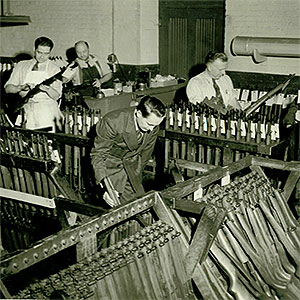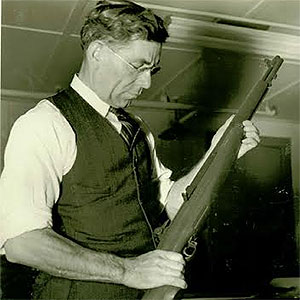M1 Garand Rifle - A Soldier's Best Friend

Springfield Armory National Historic Site/National Park Service
When American forces entered World War I in 1917, much of the military equipment, including the weapons and ammunition used on the battlefield, had to be supplied from other countries. The United States was ill prepared for a war of such magnitude. Following World War I, the Springfield Armory, the Army’s primary small arms research, development, and manufacturing facility located in Springfield, Massachusetts, began development of a new semi-automatic rifle.
By 1932, John Garand, a Springfield Armory engineer, developed a new rifle that would be adopted as the M1. The M1 rifle went into production in 1936, with an increase in military spending as political turmoil grew throughout the world. Adolph Hitler’s invasion of Poland in 1939 would topple Europe into another World War. In the ramp up to war, Springfield Armory would see a 250% budget increase in 1940 leading to new facilities and improved production practices in the manufacturing of M1 rifles. On the eve of Japan’s attack on Pearl Harbor, the Springfield Armory workforce, about 7500 people, was five times larger than it had been only a few years earlier.
The workforce would continue to grow as the United States officially entered World War II. Springfield Armory became a round-the-clock operation with three shifts working to produce M1 Rifles. At peak production, 1300 completed M1 rifles were made each shift. That is 164 rifles an hour!
The need for increased staff led to more employment opportunities for women. The Women Ordinance Workers, or WOWs, would fill most aspects of M1 production from heavy forging to stock-making. Eventually, 43% of the Springfield Armory workforce was filled by women.
By the end of the war, 3.1 million M1 rifles were manufactured at the Springfield Armory. The M1, used throughout Europe and the Pacific, became the envy of the world with General George Patton describing it as “The best battle implement ever devised.” In less than 30 years since World War I, the United States became the best equipped military in the world thanks to the Springfield Armory.
John Garand: Father of the M1 Rifle

Springfield Armory National Historic Site/National Park Service
General George Patton described it as “the greatest battle implement ever devised.” American infantrymen carried it at Normandy, Okinawa, and Inchon; from Europe to the Pacific; and from World War II through the Korean War. For over twenty years, from 1936 to 1957, it was the dependable friend of millions of United States soldiers, Marines, and sailors. Officially called the M1 rifle, this weapon that helped win the Second World War was often simply referred to as “The Garand.”
Born January 1, 1888, just outside Montreal in St. Remi, Quebec, Canada, John Cantius Garand first moved to the United States at age 11. Giving up farming, his family took up residence in Danielson, CT, a traditional New England mill village. John became a bobbin boy in a textile mill by age 12 in Jewitt City, and eventually learned a number of skills which would prove helpful later in life, such as forging, welding, and steam engineering. These early pursuits in manufacturing also began turning Garand’s mental gears. He had a knack for identifying ways of improving tools and processes, and before the age of 18 he had patented his first two inventions: a telescopic screw jack and an automatic bobbin winding machine. The next year, he began working for Brown & Sharpe Co. in Providence, RI, in the design and construction of gages..
In 1916, Mr. Garand turned his attention to the design of semiautomatic rifles, submitting a design to the US NAVY two years later. Attracting the attention of the authorities, he was requested to continue his work at the Bureau of Standards in Washington, DC. A year and a half later, Garand started work as an engineer at the government’s Springfield Armory, where he began developing a new semi-automatic rifle (a shoulder weapon lighter than a machine gun, but with a higher rate of fire compared to a traditional bolt-action rifle).
By 1932, he patented what would become the legendary M1 semi-automatic rifle. Demonstrating technology Garand had learned as a teenager, the gun operated by using expanding gasses similar to a steam engine. Weighing only 9.5 pounds, it had a rigidly-supported barrel and fired semi-automatically from an eight-shot clip. The Army officially adopted the M1 in 1936, with the Marine Corp and Navy following by 1940. A true patriot, Garand offered this amazing gun to the government royalty free. He never profited from the more than six million Garand rifles eventually produced, although there was a failed movement in Congress to give him a $100,000 grant. The inventor did receive many honors and awards such as the Gold Medal for Meritorious Service in 1941.
The M1 was finally replaced by 1957 with the M-14, a gun Garand had helped develop at Springfield. Throughout his career, Garand had invented many tools and gauges, and over five different kinds of rifles. Extremely creative, he also devised new methods and processes to assist with efficient production of his inventions. Still, only one of his many inventions became known as THE Garand. In 1941 a newspaper described the modest inventor of the famous M1 rifle: “He is of average build and average appearance, with the quiet shyness of the absorbed technician. Of French-Canadian birth, he has a shock of wavy dark hair and the rugged high cheekbones and long jaw of the down-easter. His strong individuality is shown in the fact that although he has lived in New England for 40 years, he still speaks with a marked accent.”
By the end of his life, Garand had risen through the ranks of industry, from bobbin boy to engineer, and from mechanic to inventor. He honorably retired from Springfield Armory’s civil service in 1953, and lived the rest of his life in the city with his family, including his wife Nellie, son Richard, and daughter Janice. He died February 16, 1974 at the age of 86, and was buried in Springfield’s Hillcrest Park Cemetery.
Last updated: August 4, 2017
